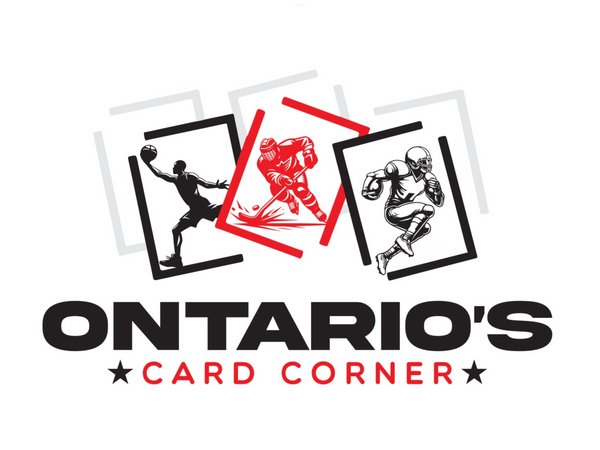How to Spot Fake Sports Cards: A Guide for Collectors
Share
Hello, collectors! Coleman Bennett here, owner of Ontario’s Card Corner. In the world of sports card collecting, authenticity is everything. Whether you’re a seasoned collector or just starting out, the last thing you want is to unknowingly add a counterfeit card to your collection. Spotting fake sports cards can be tricky, but with the right knowledge, you can protect yourself and your investment.
In this guide, I’ll walk you through the most common signs of counterfeit cards, tools you can use to verify authenticity, and tips for buying safely.
1. Understand Why Fake Cards Exist
Counterfeit sports cards are created to imitate valuable originals, often targeting high-demand rookies, vintage cards, or rare inserts. The motivation behind fakes is simple: to profit off unsuspecting collectors. Knowing this can help you stay vigilant, especially when dealing with expensive or rare cards.
2. Signs of a Fake Card
Here are some of the most common red flags to watch for:
A. Poor Printing Quality
-
What to Look For: Authentic cards have high-resolution printing, crisp text, and vibrant colors. Counterfeit cards often look blurry, pixelated, or dull.
-
Test: Use a magnifying glass to inspect the card’s surface. Genuine cards have uniform dot patterns, while fakes may have uneven or inconsistent printing.
B. Incorrect Card Stock
-
What to Look For: The thickness, texture, and weight of a card can reveal its authenticity. Counterfeit cards often use cheap materials that feel different from genuine card stock.
-
Test: Compare the card’s thickness and weight to a known authentic card from the same set.
C. Off-Centered or Misaligned Design
-
What to Look For: Authentic cards have precise alignment of borders, text, and images. Counterfeit cards often have uneven centering or misaligned features.
D. Altered Serial Numbers
-
What to Look For: On cards with serial numbers, check for inconsistencies in font, spacing, or color. Fakes may have altered or stamped numbers that don’t match the card’s style.
E. Fake Autographs
-
What to Look For: Autographs on authentic cards are often hand-signed and may include certifications. Fake autographs are usually printed or stamped onto the card.
-
Test: Use a blacklight to check for inconsistencies in ink; authentic signatures often react differently under UV light.
3. Tools to Verify Authenticity
A. Graded Cards
-
Purchasing cards graded by PSA, BGS, or SGC is one of the safest ways to ensure authenticity. Graded cards come with tamper-proof slabs and certification numbers you can verify online.
B. Online Verification Tools
-
Many grading companies offer databases where you can look up certification numbers to confirm a card’s authenticity.
C. Magnifying Glass or Loupe
-
A magnifying tool helps you inspect fine details like printing patterns and edges.
D. UV Light
-
Use a blacklight to detect hidden features, such as watermarks or authentic ink signatures.
E. Digital Scale
-
Weigh the card and compare it to a verified authentic card from the same set. Differences in weight can indicate counterfeit materials.
4. Tips for Safe Buying
A. Buy From Reputable Sources
-
Stick to trusted card shops, established dealers, and reputable online marketplaces. At Ontario’s Card Corner, we guarantee the authenticity of every card we sell.
B. Ask for Provenance
-
When purchasing high-value cards, ask for proof of origin or past ownership, such as receipts or certification numbers.
C. Avoid Deals That Are Too Good to Be True
-
If a deal seems too good to be true, it probably is. Research market prices to ensure you’re not being offered a counterfeit card at an unrealistically low price.
D. Use Buyer Protections
-
When purchasing online, use platforms that offer buyer protection, such as eBay or PayPal. This can help you recover your money if the card turns out to be fake.
5. Common Counterfeit Targets
Certain types of cards are more frequently counterfeited:
-
Rookie Cards: High-value rookies like Connor McDavid, Tom Brady, or Michael Jordan.
-
Vintage Cards: Classics like the 1952 Mickey Mantle or 1986 Michael Jordan Fleer rookie.
-
Rare Inserts and Parallels: One-of-ones, autographs, and short-print cards.
6. What to Do If You Suspect a Fake
-
Verify: Use tools like magnifying glasses or grading databases to inspect the card.
-
Consult an Expert: Bring the card to a trusted shop or experienced collector for a second opinion.
-
Report the Seller: If you bought the card online, report the seller to the platform to help prevent others from falling victim.
Final Thoughts
Spotting fake sports cards can feel daunting, but with the right tools and knowledge, you can protect yourself and your collection. At Ontario’s Card Corner, we’re committed to helping collectors navigate the hobby safely. If you’re ever unsure about a card’s authenticity, feel free to reach out—we’re here to help.
Stay vigilant, and happy collecting!
Coleman Bennett
Owner, Ontario’s Card Corner
